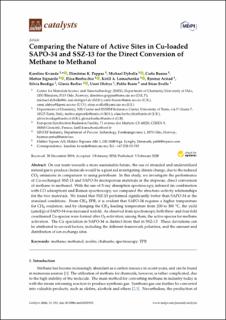| dc.contributor.author | Kvande, Karoline | |
| dc.contributor.author | Pappas, Dimitrios | |
| dc.contributor.author | Dyballa, Michael Martin | |
| dc.contributor.author | Buono, Carlo | |
| dc.contributor.author | Signorile, Matteo | |
| dc.contributor.author | Borfecchia, Elisa | |
| dc.contributor.author | Lomachenko, Kirill A. | |
| dc.contributor.author | Arstad, Bjørnar | |
| dc.contributor.author | Bordiga, Silvia | |
| dc.contributor.author | Berlier, Gloria | |
| dc.contributor.author | Olsbye, Unni | |
| dc.contributor.author | Beato, Pablo | |
| dc.contributor.author | Svelle, Stian | |
| dc.date.accessioned | 2020-10-22T07:54:57Z | |
| dc.date.available | 2020-10-22T07:54:57Z | |
| dc.date.created | 2020-02-13T10:29:50Z | |
| dc.date.issued | 2020 | |
| dc.identifier.citation | Catalysts. 2020, 10 (2), 1-17. | en_US |
| dc.identifier.issn | 2073-4344 | |
| dc.identifier.uri | https://hdl.handle.net/11250/2684337 | |
| dc.description.abstract | On our route towards a more sustainable future, the use of stranded and underutilized naturalgastoproducechemicalswouldbeagreataidinmitigatingclimatechange,duetothereduced CO2 emissions in comparison to using petroleum. In this study, we investigate the performance of Cu-exchanged SSZ-13 and SAPO-34 microporous materials in the stepwise, direct conversion of methane to methanol. With the use of X-ray absorption spectroscopy, infrared (in combination with CO adsorption) and Raman spectroscopy, we compared the structure–activity relationships for the two materials. We found that SSZ-13 performed significantly better than SAPO-34 at the standard conditions. From CH4-TPR, it is evident that SAPO-34 requires a higher temperature for CH4 oxidation, and by changing the CH4 loading temperature from 200 to 300 ◦C, the yield (µmol/g)ofSAPO-34wasincreasedtenfold. Asobservedfromspectroscopy,boththree-andfour-fold coordinated Cu-species were formed after O2-activation; among them, the active species for methane activation. The Cu speciation in SAPO-34 is distinct from that in SSZ-13. These deviations can be attributed to several factors, including the different framework polarities, and the amount and distribution of ion exchange sites. | en_US |
| dc.language.iso | eng | en_US |
| dc.publisher | MDPI | en_US |
| dc.rights | Navngivelse 4.0 Internasjonal | * |
| dc.rights.uri | http://creativecommons.org/licenses/by/4.0/deed.no | * |
| dc.subject | TPR | en_US |
| dc.subject | spectroscopy | en_US |
| dc.subject | chabazite | en_US |
| dc.subject | zeolite | en_US |
| dc.subject | methanol | en_US |
| dc.subject | methane | en_US |
| dc.title | Comparing the Nature of Active Sites in Cu-loaded SAPO-34 and SSZ-13 for the Direct Conversion of Methane to Methanol | en_US |
| dc.type | Peer reviewed | en_US |
| dc.type | Journal article | en_US |
| dc.description.version | publishedVersion | en_US |
| dc.rights.holder | © 2020 by the authors. Licensee MDPI, Basel, Switzerland. This article is an open access article distributed under the terms and conditions of the Creative Commons Attribution (CC BY) license (http://creativecommons.org/licenses/by/4.0/). | en_US |
| dc.source.pagenumber | 1-17 | en_US |
| dc.source.volume | 10 | en_US |
| dc.source.journal | Catalysts | en_US |
| dc.source.issue | 2 | en_US |
| dc.identifier.doi | 10.3390/catal10020191 | |
| dc.identifier.cristin | 1793759 | |
| dc.relation.project | Norges forskningsråd: 237922 | en_US |
| cristin.ispublished | true | |
| cristin.fulltext | original | |
| cristin.qualitycode | 1 | |

